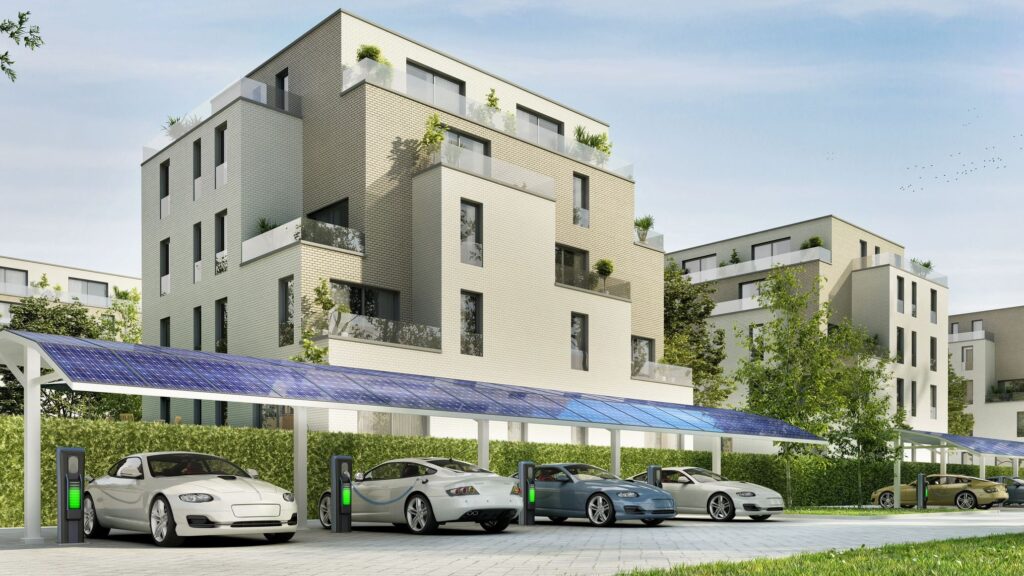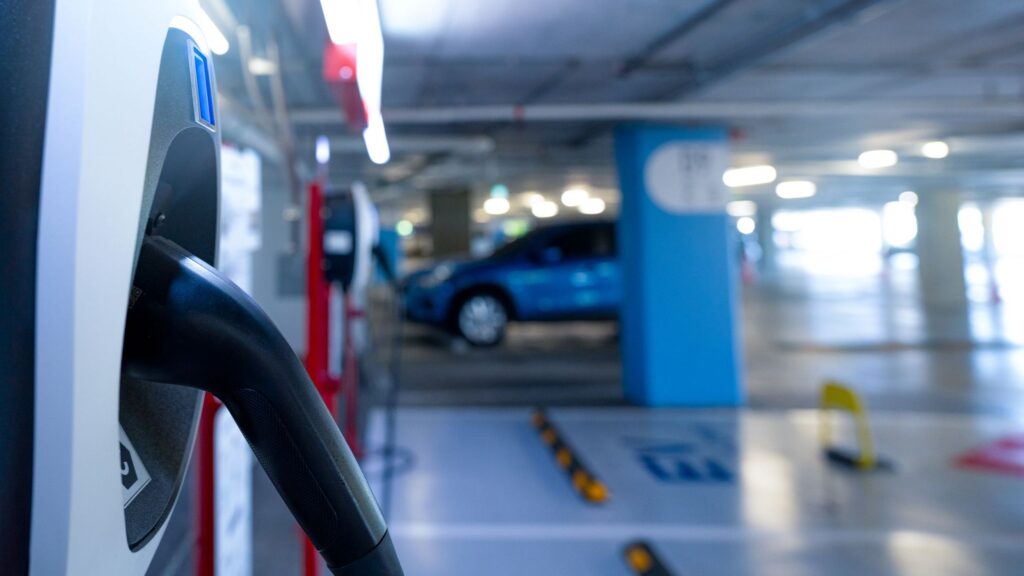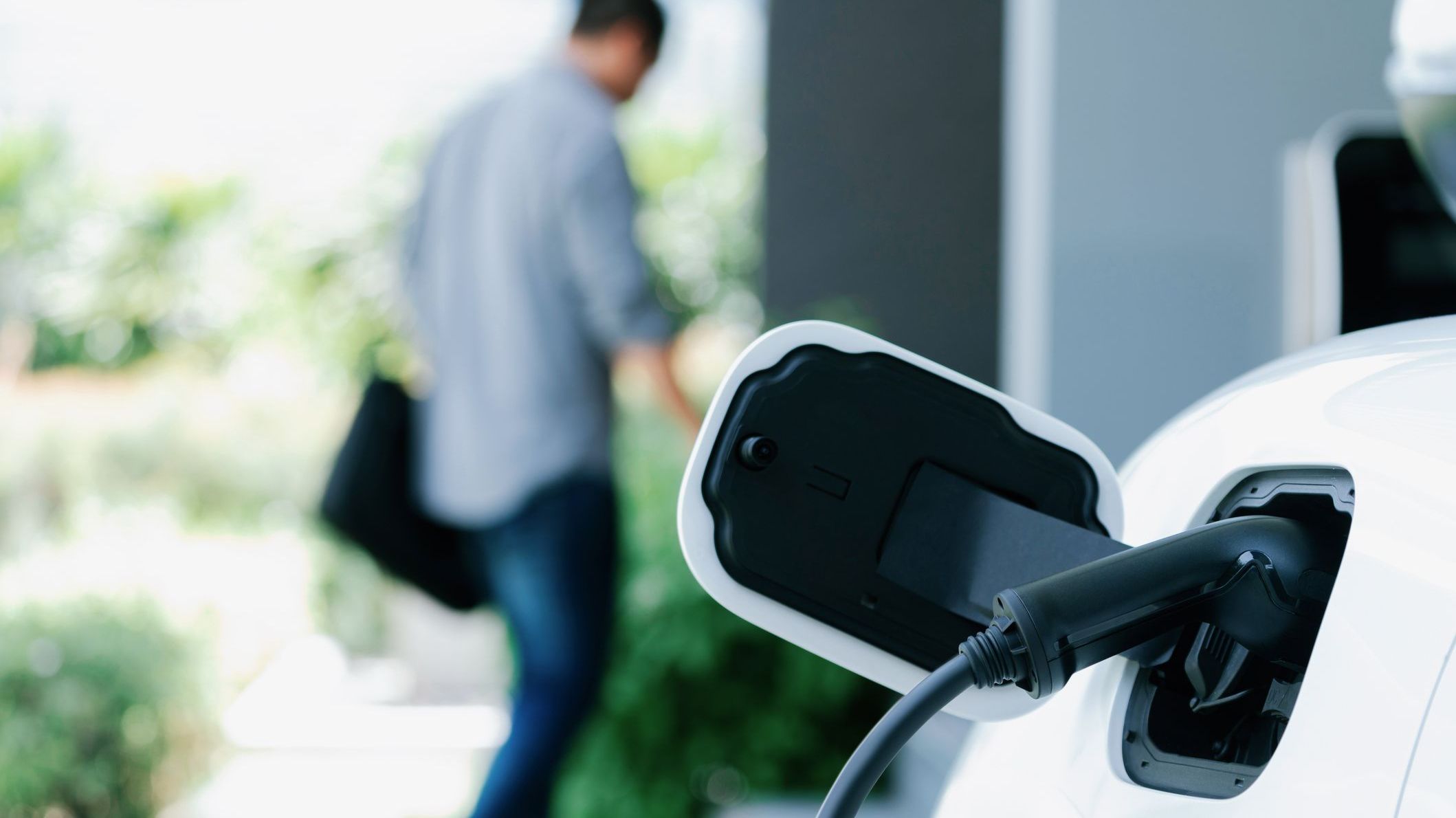As electric vehicle adoption accelerates across the globe, a fundamental shift in our fueling paradigm is taking place. Gas stations are no longer the primary refueling points—buildings are becoming the new energy hubs. For building engineers, facility managers, and property owners, this transformation presents both significant challenges and opportunities. Those who prepare now will avoid costly retrofits while positioning their properties as desirable, future-ready assets.
Hate to read? Listen to a podcast episode on this topic. Visit the NOXTalks Podcast for more episodes

The EV Surge Is Here—Ready or Not
EV sales grew by over 35% globally in 2023, with more than 14 million vehicles sold (IEA, 2023)[1]. Industry projections suggest EVs will represent approximately 45% of new car sales by 2030 in major markets. This rapid adoption means building owners no longer have the luxury of treating EV charging as a “nice-to-have” amenity—it’s becoming an essential utility.
According to the International Energy Agency, more than 80% of EV charging currently happens at home or work, placing commercial buildings at the center of this energy transition (IEA, 2023)[1]. Buildings unprepared for this shift face not only tenant dissatisfaction but also potential compliance issues as more municipalities introduce EV-ready building codes.
Understanding the Technical Foundation
Before installing a single charging station, building professionals must develop a comprehensive understanding of their electrical infrastructure’s capacity.
Load Assessment and Capacity Planning
The first step is conducting a thorough electrical load assessment. Most existing buildings weren’t designed with EV charging in mind, and electrical systems may already be operating close to capacity. A professional load analysis will determine:
- Available capacity in existing electrical service
- Peak demand patterns throughout the day
- Potential for load shifting or balancing
- Upgrade requirements to support desired charging infrastructure
“The most expensive mistake we see is owners installing a few chargers without considering future expansion,” explains John Harris, an electrical engineer cited in the RMI report. “This often leads to expensive panel upgrades or service modifications that could have been avoided with proper planning.” (RMI, 2020)[5]
Infrastructure Options and Considerations
EV charging infrastructure broadly falls into three categories:
- Level 1 Charging (120V, standard outlet): Provides 3-5 miles of range per hour of charging. While inexpensive to install, it’s generally insufficient for commercial applications except for workplace charging where vehicles remain parked for 8+ hours.
- Level 2 Charging (208-240V): Delivers 12-80 miles of range per hour, depending on the vehicle and power delivery capability. This represents the standard for most commercial applications.
- DC Fast Charging (480V+): Provides 100+ miles of range in 30 minutes but requires substantial electrical capacity and incurs higher installation costs. Typically used in retail or public settings rather than office buildings or residential properties (U.S. Department of Energy, 2025)[2].
For most commercial buildings, a combination of Level 2 chargers with smart load management offers the optimal balance of functionality and cost-effectiveness.

Smart Infrastructure: Beyond Basic Charging
Modern EV charging infrastructure should incorporate intelligence that extends beyond basic power delivery.
Load Management Systems
Smart load management systems can reduce infrastructure costs by 30-70% by dynamically allocating available power across multiple charging stations (RMI, 2020)[5]. Instead of sizing electrical infrastructure for worst-case scenarios (all chargers operating at maximum capacity simultaneously), these systems monitor total electricity usage and adjust charging rates accordingly.
Technologies like Automated Load Management (ALM) allow buildings to support more chargers than would otherwise be possible with existing electrical service. Building codes increasingly recognize ALM as an acceptable alternative to electrical service upgrades.
Integration with Building Management Systems
Forward-thinking facility managers are integrating EV charging with existing BMS. This integration enables:
- Coordination with other building systems to avoid demand charges
- Participation in utility demand response programs
- Energy optimization across all building systems
- Centralized monitoring and management
“EV charging doesn’t operate in isolation,” notes EV infrastructure expert Sarah Chen in the U.S. EPA’s guidance document. “The most effective implementations view charging as one component in a holistic energy management strategy.” (U.S. EPA, 2021)[3]
The Economics of EV Infrastructure
Understanding the financial aspects of EV charging is critical for building owners and managers.
Cost Recovery and Billing Systems
Different property types require different billing approaches:
- Commercial Office Buildings: Typically implement employee reimbursement systems or negotiate charging costs within tenant leases.
- Multi-Family Housing: May utilize submetering, networked billing systems, or include charging in rent/HOA fees.
- Retail Properties: Often use pay-per-use systems that may offer free initial periods to attract customers.
Modern networked charging systems offer multiple payment options, including mobile apps, RFID cards, and credit card processing. These systems also provide detailed usage reporting for accurate billing and energy monitoring.
Incentives and Funding Opportunities
Numerous incentives can significantly offset installation costs:
- Federal tax incentives like the Alternative Fuel Infrastructure Tax Credit
- State and local rebate programs
- Utility make-ready programs that cover infrastructure costs
- Workplace charging grants
Many utilities also offer special EV charging rates designed to encourage off-peak charging, which can dramatically improve operating economics.

Future-Proofing Your Investment
Technology evolves rapidly, making future-proofing essential for any EV infrastructure investment.
Scalable Design Principles
Key future-proofing strategies include:
- Installing conduit and electrical capacity for future expansion, even if fewer chargers are deployed initially (NEMA, 2022)[6]
- Choosing systems with open protocols like OCPP (Open Charge Point Protocol) to ensure interoperability (Open Charge Alliance, 2024)[4]
- Designing parking areas with charging in mind, including cable management and accessibility considerations
- Planning for bidirectional charging capability (V2G/V2B) which allows vehicles to return power to buildings or the grid
Vehicle-to-Building Integration
The most forward-thinking building managers are preparing for vehicle-to-building (V2B) capabilities, where EV batteries can serve as distributed energy resources. During peak demand periods or power outages, this technology allows buildings to draw power from connected vehicles, providing valuable resiliency benefits.
“We’re just beginning to see the integration of EVs into building energy systems,” explains energy systems researcher Michael Wong, “Buildings that prepare for this integration now will have significant advantages in energy resilience and operating costs within five years.” (NEMA, 2022)[6]
Regulatory Landscape and Compliance
The regulatory environment surrounding EV charging is rapidly evolving. Building codes in many jurisdictions now mandate EV-ready or EV-capable spaces in new construction and major renovations. Understanding these requirements is essential for compliance and future-proofing.
Common requirements include:
- Minimum percentages of parking spaces that must be EV-ready
- Electrical capacity requirements for charging infrastructure
- Accessibility standards for EV charging stations
- Safety specifications for installation and operation (U.S. EPA, 2021)[3]
Conclusion: Strategic Implementation
The transition to electric vehicles represents one of the most significant shifts in building infrastructure requirements in decades. Building professionals who take a strategic approach—assessing capacity, implementing scalable solutions, integrating with existing systems, and planning for future technologies—will deliver significant value to property owners and occupants.
As EVs continue their march toward market dominance, buildings that fail to adapt will face increasingly expensive retrofits and potential obsolescence in the market. The question is no longer if your building will need to accommodate EV charging, but how effectively you’ll implement the necessary infrastructure.
The most successful building professionals will view EV charging not as an isolated system but as an integral component of a building’s overall energy ecosystem—one that can provide benefits far beyond simply charging vehicles.
References
- International Energy Agency. (2023). “Global EV Outlook 2023.” Retrieved from https://www.iea.org/reports/global-ev-outlook-2023 (Analysis of global EV market growth and charging infrastructure deployment)
- U.S. Department of Energy. (2025). “Alternative Fuels Data Center: Alternative Fueling Station Locator.” Retrieved from https://afdc.energy.gov/stations
- U.S. Environmental Protection Agency. (2021). “An Introduction to Electric Vehicle-Ready Buildings.” Retrieved from https://www.epa.gov/sites/default/files/2021-04/documents/webinar-ev-ready-buildings-2021-03-24.pdf (Guidelines for EV infrastructure in commercial and residential buildings)
- Open Charge Alliance. (2024). “Open Charge Point Protocol (OCPP) 1.6.” Retrieved from https://openchargealliance.org/protocols/open-charge-point-protocol/#OCPP1.6 (Technical standards for EV charging station communications protocols)
- Rocky Mountain Institute. (2020). “Reducing EV Charging Infrastructure Costs.” Retrieved from https://rmi.org/insight/reducing-ev-charging-infrastructure-costs/ (Best practices for commercial building EV infrastructure planning and cost reduction)
- National Electrical Manufacturers Association. (2022). “NEMA Comments to FHWA on Electric Vehicle Charging Infrastructure.” Retrieved from https://www.nema.org/docs/default-source/advocacy-document-library/fhwa–guidance-for-evse-deployment-comments.pdf (Electrical standards and planning resources for building professionals)

